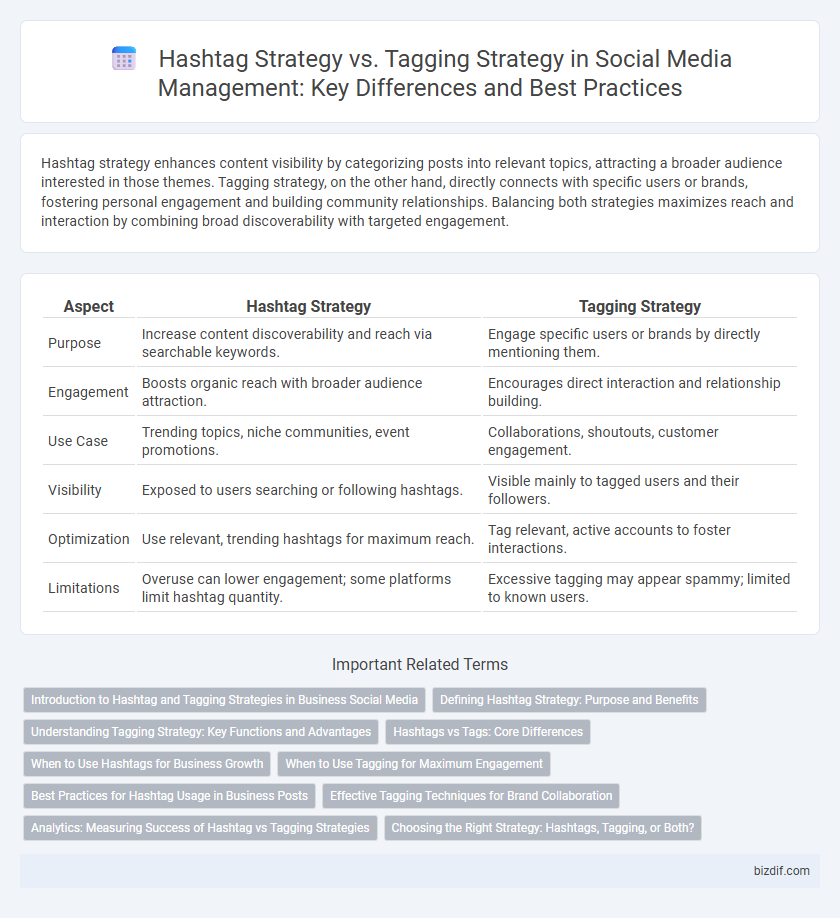Hashtag strategy enhances content visibility by categorizing posts into relevant topics, attracting a broader audience interested in those themes. Tagging strategy, on the other hand, directly connects with specific users or brands, fostering personal engagement and building community relationships. Balancing both strategies maximizes reach and interaction by combining broad discoverability with targeted engagement.
Table of Comparison
| Aspect | Hashtag Strategy | Tagging Strategy |
|---|---|---|
| Purpose | Increase content discoverability and reach via searchable keywords. | Engage specific users or brands by directly mentioning them. |
| Engagement | Boosts organic reach with broader audience attraction. | Encourages direct interaction and relationship building. |
| Use Case | Trending topics, niche communities, event promotions. | Collaborations, shoutouts, customer engagement. |
| Visibility | Exposed to users searching or following hashtags. | Visible mainly to tagged users and their followers. |
| Optimization | Use relevant, trending hashtags for maximum reach. | Tag relevant, active accounts to foster interactions. |
| Limitations | Overuse can lower engagement; some platforms limit hashtag quantity. | Excessive tagging may appear spammy; limited to known users. |
Introduction to Hashtag and Tagging Strategies in Business Social Media
Hashtag strategy in business social media involves using targeted keywords preceded by the "#" symbol to increase content visibility, attract niche audiences, and enhance discoverability across platforms like Instagram, Twitter, and LinkedIn. Tagging strategy focuses on mentioning specific users, collaborators, or brands to foster engagement, build relationships, and increase post reach through direct notifications. Combining optimized hashtags and strategic tagging drives higher organic reach and improves audience interaction for social media campaigns.
Defining Hashtag Strategy: Purpose and Benefits
Hashtag strategy involves selecting relevant, trending, and niche-specific hashtags to increase content visibility and engagement by categorizing posts within broader social conversations. It helps target specific audience segments, enhances discoverability through search functions, and amplifies brand reach across social platforms. Effective hashtag use drives organic growth by connecting content to user interests and current trends, boosting overall social media performance.
Understanding Tagging Strategy: Key Functions and Advantages
Tagging strategy in social media management enhances content discoverability by directly connecting posts to users, brands, or relevant topics through mentions or location tags. This approach fosters engagement, builds relationships, and leverages the network effects of tagged entities, driving more targeted interactions than generic hashtag use. Tagging also enables precise tracking of collaborations, influencer partnerships, and audience reach, offering detailed insights for optimizing marketing campaigns.
Hashtags vs Tags: Core Differences
Hashtag strategy leverages keywords to categorize content and increase discoverability across social platforms, enhancing organic reach through trending and niche tags. Tagging strategy involves directly mentioning users or brands to foster engagement, create connections, and boost visibility within specific communities. The core difference lies in hashtags targeting broader audience discovery, while tags aim at personalized interactions and relationship-building.
When to Use Hashtags for Business Growth
Using hashtags strategically on social media platforms can significantly enhance business growth by increasing content visibility and targeting specific audiences based on interests or trends. Hashtags are most effective when launching new campaigns, promoting events, or entering trending conversations to boost reach and engagement beyond existing followers. By combining popular, niche, and branded hashtags, businesses can improve searchability and attract potential customers relevant to their industry and offerings.
When to Use Tagging for Maximum Engagement
Tagging users in social media posts is most effective when you want to directly involve individuals or brands, encouraging personal interaction and increasing post visibility among their followers. Use tagging for collaborations, acknowledgments, or when highlighting influencers to boost engagement through authentic connections. This strategy drives higher reach and trust compared to generic hashtag use, especially in niche or community-driven content.
Best Practices for Hashtag Usage in Business Posts
Effective hashtag usage in business posts involves selecting relevant, niche-specific hashtags that enhance content discoverability while avoiding overuse to prevent appearing spammy. Incorporating a mix of trending, branded, and community hashtags maximizes audience reach and engagement. Strategic tagging of influencers or related accounts complements hashtags by fostering connections and increasing post visibility within targeted networks.
Effective Tagging Techniques for Brand Collaboration
Effective tagging techniques for brand collaboration involve strategically tagging relevant influencers, partners, and brand accounts to increase visibility and engagement. Utilizing specific and niche hashtags alongside tagging can amplify reach while fostering authentic connections within the target audience. Consistent analysis of engagement metrics helps refine tagging strategies to maximize collaborative campaign performance.
Analytics: Measuring Success of Hashtag vs Tagging Strategies
Hashtag strategy enables broad audience reach by categorizing content for trending and niche discovery, while tagging strategy directly engages specific users or brands, fostering personalized interaction and network growth. Analytics reveal that hashtags drive higher impressions and organic reach, whereas tagging shows increased engagement rates and stronger community relationships. Effective social media management balances both, using data analytics to optimize for campaign goals like awareness, engagement, or conversions.
Choosing the Right Strategy: Hashtags, Tagging, or Both?
Choosing the right social media strategy involves understanding the distinct benefits of hashtags and tagging: hashtags improve content discoverability by categorizing posts under popular or niche topics, while tagging engages specific users or brands, fostering direct interaction and relationship building. Combining both strategies maximizes reach and engagement by attracting broader audiences through hashtags and encouraging personalized connections via tags. Analyzing platform-specific algorithms and audience behavior helps tailor the optimal mix, ensuring enhanced visibility and community growth in social media management.
hashtag strategy vs tagging strategy Infographic

 bizdif.com
bizdif.com